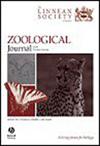葡萄牙上侏罗统沼泽异特龙1877年新标本(兽脚目:异特龙科)的颅骨学及异特龙的标本级系统发育分析
IF 2.8
2区 生物学
Q1 ZOOLOGY
引用次数: 0
摘要
1999年,在葡萄牙的上侏罗世,人们根据在庞巴尔的安德里萨斯化石遗址收集的一组颅骨残骸首次描述了脆弱异特龙。第二种异特龙(Allosaurus europaeus)的描述是基于在Lourinhã的Praia de Vale Frades收集的一个关节颅骨的后部和颈椎序列(ML 415),一直存在争议,其有效性受到质疑。详细描述了在安德雷萨斯收集的一个新的头骨化石材料样本,该样本可以秘密地归因于异特龙。此外,本文还对莫里森组异特龙化石记录进行了全面的系统发育评价。这一分析表明,在北美晚侏罗世生态系统中,只有两个有效的异特龙物种:脆弱异特龙和jimmadseni异特龙。本文提出了一种对脆弱异特龙的修正诊断。葡萄牙标本MNHN/ ul和。#、ML 415和MG 27804在这里被解释为属于脆弱异特龙。这一解释对于更好地理解卢西塔尼亚盆地兽脚亚目动物群的进化史具有重要意义,支持了基默里吉纪-泰托尼亚期原北大西洋两岸大陆之间存在密切的生物地理关系。本文章由计算机程序翻译,如有差异,请以英文原文为准。
Cranial osteology of a new specimen of Allosaurus Marsh, 1877 (Theropoda: Allosauridae) from the Upper Jurassic of Portugal and a specimen-level phylogenetic analysis of Allosaurus
Allosaurus fragilis was first described in the Upper Jurassic of Portugal in 1999 based on a set of postcranial remains collected at the Andrés fossil site in Pombal. The description of a second species, Allosaurus europaeus, based on a posterior part of an articulated skull and a sequence of cervical vertebrae (ML 415) collected at Praia de Vale Frades in Lourinhã, has been controversial, and its validity has been challenged. A detailed description of a new sample of cranial fossil material collected at Andrés that can be confidentially attributed to Allosaurus is presented. In addition, a comprehensive phylogenetic assessment of the Morrison Formation fossil record of Allosaurus is also performed. This analysis indicates that only two valid Allosaurus species were present in the Late Jurassic ecosystems of North America: Allosaurus fragilis and Allosaurus jimmadseni. An emended diagnosis for Allosaurus fragilis is here proposed. The Portuguese specimens MNHN/UL.AND.#, ML 415, and MG 27804 are here interpreted as belonging to Allosaurus fragilis. This interpretation has important implications to better understand the evolutionary history of the theropod fauna of the Lusitanian Basin, supporting the existence of close biogeographic relationships between the landmasses on both sides of the proto-North Atlantic Ocean during the Kimmeridgian–Tithonian.
求助全文
通过发布文献求助,成功后即可免费获取论文全文。
去求助
来源期刊
CiteScore
6.50
自引率
10.70%
发文量
116
审稿时长
6-12 weeks
期刊介绍:
The Zoological Journal of the Linnean Society publishes papers on systematic and evolutionary zoology and comparative, functional and other studies where relevant to these areas. Studies of extinct as well as living animals are included. Reviews are also published; these may be invited by the Editorial Board, but uninvited reviews may also be considered. The Zoological Journal also has a wide circulation amongst zoologists and although narrowly specialized papers are not excluded, potential authors should bear that readership in mind.

 求助内容:
求助内容: 应助结果提醒方式:
应助结果提醒方式:


